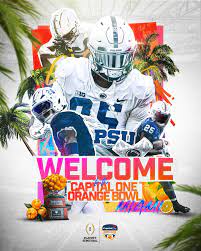TRAVELFocus: Miami's Orange Bowl showcases sports royalty in Penn State and Notre Dame
- T. Craig
- Jan 8
- 3 min read
Updated: Jan 21
by Tony Lesesne

Warm weather, palm tree and beaches and iconic football. YES, This time, the college football world will witness a clash of titans as Penn State and Notre Dame face off in the Orange Bowl. Both programs boast legendary histories, renowned brands, and a relentless pursuit of excellence. This game transcends mere athletic competition; it's a microcosm of the complex realities of modern college football.
Historical Success and Modern Challenges:
Penn State and Notre Dame are synonymous with college football success. Their storied traditions, iconic coaches (Joe Paterno and Knute Rockne, respectively), and Heisman Trophy winners have cemented their places in college football lore. However, both programs have grappled with their own set of challenges in recent years.
Academic Success: While both institutions emphasize academics, graduation rates for student-athletes can vary. Examining these figures provides valuable insights into the academic support systems offered by each university.
Opportunities for Minorities: Both schools have made strides in diversifying their rosters and coaching staffs. Analyzing the opportunities available to minority students, both academically and athletically, is crucial.
The Evolving Landscape of College Football: The advent of the transfer portal and the ability for athletes to profit from their name, image, and likeness (NIL) has dramatically altered the landscape of college football. This has significant implications for both players and institutions, impacting everything from recruiting strategies to program finances.

The Economics of College Football:
College football is a multi-billion dollar industry. Sellout crowds, lucrative television contracts, and the commercialization of the sport generate immense revenue.
Athlete Compensation: While players now benefit from NIL deals, the debate around fair compensation for athletes continues. The revenue generated by these players, particularly during high-profile games like the Orange Bowl, raises questions about the equitable distribution of wealth within the sport.
The Role of Coaches: Coaches play a pivotal role in the success of a program, commanding significant salaries and enjoying substantial influence.
A Reflection of Society:
The matchup between Penn State and Notre Dame also reflects broader societal issues.
Social and Cultural Dynamics: Both schools, despite their predominantly white student bodies, field predominantly Black athletes. This dynamic raises questions about race, representation, and the role of athletes in higher education.
The Impact of College Football on Local Economies: The Orange Bowl itself has a significant economic impact on the Miami community, generating revenue for hotels, restaurants, and local businesses.
THE ORANGE BOWL

The Orange Bowl, established in 1935, is a prestigious college football bowl game played annually in Miami, Florida.
Historical Significance: It's one of the oldest and most renowned bowl games, consistently featuring top-tier college football programs.
Miami's Role: Played in Miami since its inception, the Orange Bowl has become synonymous with the city, boosting tourism and showcasing South Florida to a national audience.
Playoff Contender: As part of the College Football Playoff, the Orange Bowl now hosts one of the semifinal games, further elevating its importance in determining the national champion.
The Orange Bowl's rich history and its role as a premier postseason matchup make it a significant event in the college football landscape.
The Orange Bowl is more than just a football game; it's a reflection of the complex realities of modern college football. It's a platform to discuss academic success, athlete compensation, social justice, and the evolving relationship between athletes and institutions. As fans enjoy the spectacle, it's important to consider the broader implications of this high-stakes clash.












コメント